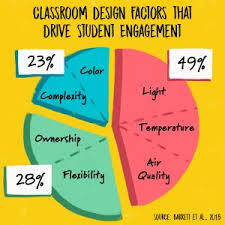Whether students are absorbing academic material, practicing reading social signs, or using tactile experiences to make sense of their surroundings, children in school are always learning. To guarantee that students truly retain the knowledge imparted during classes, teachers with a certificate in Educational Administration must make sure their classroom environment facilitates learning retention. With furnishings and layouts that support student-led learning and collaboration, classroom design is gradually shifting toward active learning.
8 General Best Practices For Your Proposed Classroom Design

Here are specific things you can do to make your classroom a better space for your learners:
1. Minimalize Your Space
Adopt a minimalistic design philosophy for your classroom and get input from your pupils on what they like and dislike about it. To check if you can teach without certain elements in the classroom, try removing them for a short while.
Give top priority to innovative organizing ideas that remove ongoing work off the walls, the floor, countertops, and tables. In general, you want a tidy environment that best gets pupils ready to concentrate on the task at hand.
Do you follow us on Social Media? We regularly share upgraded educational content, tips, feedback, and more. Check us out by clicking the profiles here - Facebook / Twitter / LinkedIn / Pinterest / Instagram / YouTube
2. Offer Flexible Seating Options
In contrast to the conventional teacher-centered model, grade school education is gradually shifting toward a student-centered approach.
Many students learn better when they are actively involved in the learning process and are not confined to a chair and facing forward for the duration of a class. Provide flexible seating alternatives that may be relocated or removed for various learning activities to assist all pupils.
3. Use Colours Strategically
The use of color may significantly enhance the appearance of your classroom. It goes beyond simply redesigning your classroom's appearance. We utilize colors, and our brains react to them in different ways. For example, colors like orange and red are more exciting.
These colors work well in an environment that promotes creativity or focus. Greens and blues are more calming hues for a classroom or study area where the emphasis is on being cool-headed rather than frenzied. A reading nook might be made to seem calmer by adding a green cushion and a blue bean bag.
4. Create Collaboration Spaces
Group work is greatly facilitated when students' desks are swapped out for shared tables since they don't have to move or adjust their desks to collaborate. Because interacting with others enables young kids to practice lifetime skills.
This includes communication, problem-solving, compromise, and sharing, shared spaces also improve students' social-emotional growth. Make sure there is a designated area in the classroom for group discussions or collaborative work, even if you are unable to seat kids at shared tables.
5. Add Spaces To Highlight Student Achievements
Ensuring a designated area for completed assignments helps foster a sense of pride in students as they like seeing proof of their accomplishments. Students can readily refer to the results of their efforts.
Whether it's a diorama from a course on marine habitats or posters explaining fractions, displaying completed projects may also help make learning tangible. Take care not to overcrowd the walls. Set up a digital display portfolio that children and their families may access from home at any time, or maintain a regular timetable for students to bring their creations home.
6. Increase Writable Spaces
Though they are classic, composition notebooks are by no means the sole writing surface offered to pupils in the modern classroom. Students can utilize various resources such as digital whiteboards, tablets, chalkboards, and personal whiteboards for their written assignments.
The role of ‘keepers’ of the writing surfaces is no longer necessary for teachers. For student-led learning, paint a classroom wall white with chalkboard paint. Alternatively, cover students' desks with dry-erase vinyl for in-class activities.
7. Ensure the Use Of Technology
Excellent instructional technology entails a tremendous deal of responsibility for both teachers and pupils. When introducing new technology into the classroom, educators must ensure that it will complement their current teaching methods rather than take it over. Similarly, the main goal of new technological tools should be to enhance learning rather than divert attention from it.
Educational technology should not detract from course material. Make sure that equipment like laptops and tablets is kept in a safe and secure location while not in use in terms of the physical space. Provide ample room for students to collaborate if they are using shared technology so that everyone has equal access to it.
8. Reduce Teacher Footprint
The front of the classroom is where all the attention is focused on teacher-centered learning; this is the teacher's domain. But in classrooms where students come first, the teacher's place is less important. During lessons, a teacher who sits or walks among the pupils fosters more dynamic engagement and student-teacher communication.
For paperwork and organizing needs, the majority of instructors still require a designated area. However, they should schedule time to tidy this area after each workday. Follow suit with the remaining areas of the classroom; each morning, you and your pupils should arrive to find a tidy classroom prepared for further instruction.
Create A Classroom That Interests Your Students
Students get more interested when a classroom is decorated. You may also create a visually appealing background for your online class if you are an instructor. Redesigning your classroom from scratch may seem like a daunting task, but keep in mind that it's a continuous process. Therefore, enroll yourself in Management & Leadership Program, start small, involve students in the process, and iterate as you go rather than trying to revamp everything at once.
We believe education should be accessible for everyone. That’s why we don’t charge for our blogs. Find the right course that will help you in your career with us, contact us at - 1800–212–6400. You can mail us at act@asiancollegeofteachers.com









